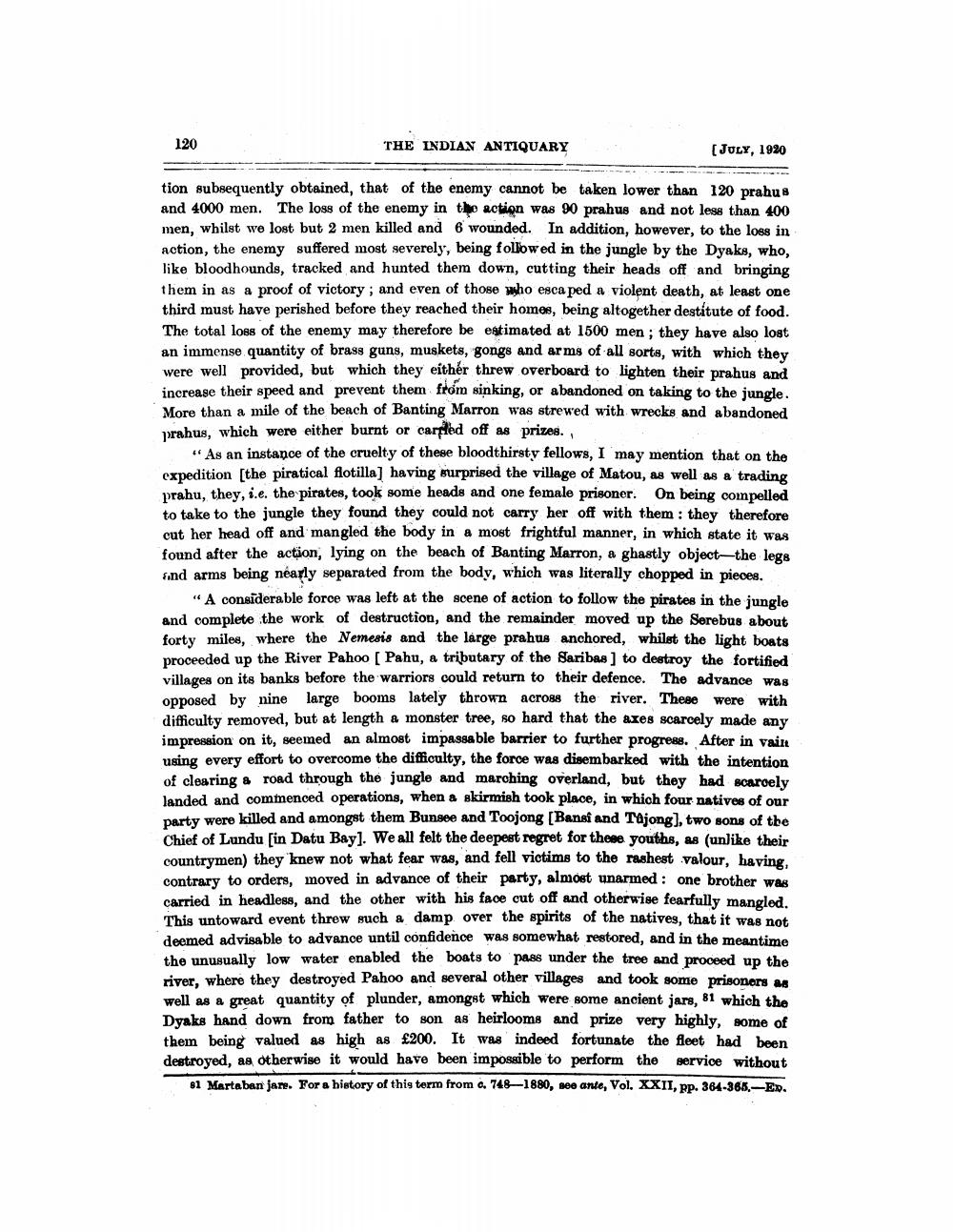________________
120
THE INDIAN ANTIQUARY
[JULY, 1920
-
-
-
-
tion subsequently obtained, that of the enemy cannot be taken lower than 120 prahus and 4000 men. The loss of the enemy in the action was 90 prahus and not less than 400 men, whilst we lost but 2 men killed and 6 wounded. In addition, however, to the loss in action, the enemy suffered most severely, being followed in the jungle by the Dyaks, who, like bloodhounds, tracked and hunted them down, cutting their heads off and bringing them in as a proof of victory; and even of those who escaped a violent death, at least one third must have perished before they reached their homes, being altogether destitute of food. The total loss of the enemy may therefore be estimated at 1500 men ; they have also lost an immense quantity of brass guns, muskets, gongs and arms of all sorts, with which they were well provided, but which they either threw overboard to lighten their prahus and increase their speed and prevent them from sinking, or abandoned on taking to the jungle. More than a mile of the beach of Banting Marron was strewed with wrecks and abandoned prahus, which were either burnt or carpled off as prizes.,
"As an instance of the cruelty of these bloodthirsty fellows, I may mention that on the expedition [the piratical flotilla) having surprised the village of Matou, as well as a trading prahu, they, i.e. the pirates, took some heads and one female prisoner. On being compelled to take to the jungle they found they could not carry her off with them : they therefore cut her head off and mangled the body in a most frightful manner, in which state it was found after the action, lying on the beach of Banting Marron, a ghastly object-the lege s.nd arms being nearly separated from the body, which was literally chopped in pieces.
"A considerable force was left at the scene of action to follow the pirates in the jungle and complete the work of destruction, and the remainder moved up the Serebus about forty miles, where the Nemesis and the large prahus anchored, whilst the light boats proceeded up the River Pahoo [ Pahu, a tributary of the Saribas ] to destroy the fortified villages on its banks before the warriors could return to their defence. The advance was opposed by nine large booms lately thrown across the river. These were with difficulty removed, but at length a monster tree, so hard that the axes scarcely made any impression on it, seemed an almost impassable barrier to further progress. After in vain using every effort to overcome the difficulty, the force was disembarked with the intention of clearing & road through the jungle and marching overland, but they had scarcely Janded and commenced operations, when a skirmish took place, in which four natives of our party were killed and amongst them Bungee and Toojong (Bans and Tajong), two sons of the Chief of Lundu [in Datu Bay]. We all felt the deepest regret for these youths, as (unlike their countrymen) they knew not what fear was, and fell victims to the rashest valour, having. contrary to orders, moved in advance of their party, almost unarmed: one brother was carried in headless, and the other with his face cut off and otherwise fearfully mangled. This untoward event threw such a damp over the spirits of the natives, that it was not deemed advisable to advance until confidence was somewhat restored, and in the meantime the unusually low water enabled the boats to pass under the tree and proceed up the river, where they destroyed Pahoo and several other villages and took some prisoners as well as a great quantity of plunder, amongst which were some ancient jars, 81 which the Dyake hand down from father to son as heirlooms and prize very highly, some of them being valued as high as £200. It was indeed fortunate the fleet had been destroyed, as otherwise it would have been impossible to perform the service without
81 Martaban jare. For a history of this term from c. 748–1880, see ante, Vol. XXII, pp. 384-365.ED.




